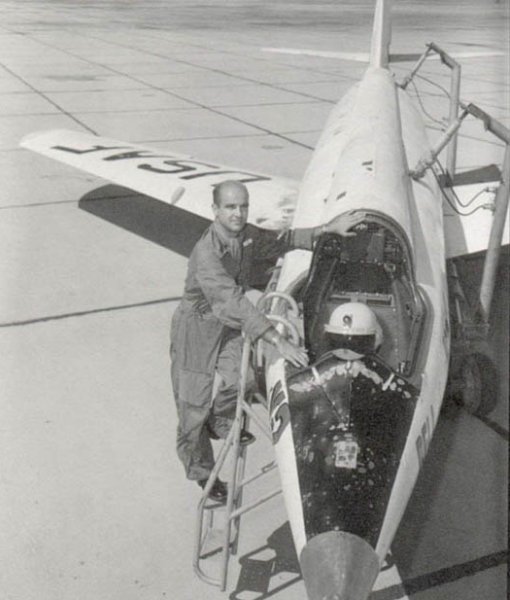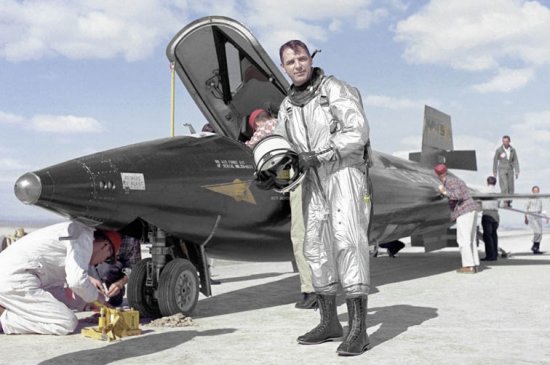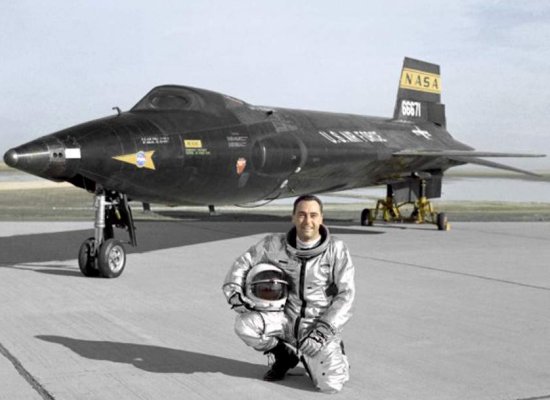|
||||||||||
|
|
||||||||||
|
||||||||||
|
|
||||||||||
While it took six years to advance from the Mach 1 X-1 to the Mach 2 Skyrocket, it took only half as long to reach the next Mach milestone. The first pilot to achieve Mach 3 was another Air Force test pilot named Milburn Apt. Apt did so on 27 September 1956 aboard a Bell X-2 research plane during its thirteenth powered flight. The X-2 was carried aboard its EB-50 mother plane to high altitude where it was launched on a textbook trajectory to reach Mach 3. During its flight, the X-2 reached a maximum speed of Mach 3.196, or 2,094 mph (3,370 km/h) at an altitude of 65,607 ft (19,995 m).

Unfortunately, Captain Apt had essentially no experience in the X-2 prior to his record-breaking flight. This flight was actually his very first aboard the aircraft, with tragic consequences. As he was turning the plane to return to Edwards Air Force Base, Apt did not slow down sufficiently and the plane flipped around so that the nose was flying backwards. He was unable to overcome this effect, known as inertia coupling, and lost control of the X-2. Capt. Apt had no other choice than to eject, a complicated maneuver aboard a plane traveling at such high speeds. In order to eject, the nose capsule of the X-2 was designed to separate from the rest of the plane and trail a streamer. The streamer would slow the capsule down until the pilot could open the canopy and bail out. Regrettably, Apt was at too low an altitude when the capsule ejected and he was only able to pull himself halfway out of the cockpit by the time it struck the ground. Apt perished in the fatal accident, and the remains of the X-2 were buried at an unknown location within Edwards. The first X-2 had also been lost when it exploded over Lake Ontario in 1953, and no example of this historic plane remains today.
High-speed milestones continued to be surpassed at a breathtaking pace during the 1960s, all thanks to the exploits of what many consider to be the most famous and successful research plane in history. The North American X-15 exceeded Mach 4 for the first time on 7 March 1961. The top speed reached on this flight was Mach 4.43, or 2,905 mph (4,675 km/h) at an altitude of 77,450 ft (23,605 m) . At the controls during this record-setting mission was Captain Robert White of the US Air Force.

Three months later on 23 June 1961, Bob White was again in command of an X-15 when the plane reached the next milestone of Mach 5. The maximum speed attained on this flight was 3,603 mph (5,800 km/h) at 107,700 ft (32,830 m), or Mach 5.27. White was at the controls yet again on 11 September 1961 when he became the first pilot to exceed Mach 6. White set a new speed record on this flight of Mach 6.04, or 4,094 mph (6,590 km/h) at 101,600 ft (30,970 m). Although it had taken nine years to go from Mach 1 to Mach 3, the X-15 was able to reach from Mach 4 to Mach 6 in just nine months!

The absolute speed record for the X-15 was set a few years later by fellow test pilot William "Pete" Knight. On 3 October 1967, Knight attained a speed of 4,520 mph (7,274 km/h) at 102,100 ft (31,120 m) or Mach 6.72. Knight's record has stood as the highest speed attained by a manned, powered airplane ever since.
The only craft that have traveled faster than the X-15 are unmanned vehicles like missiles or manned spacecraft
like the Space Shuttle. On 27 March 2004, NASA's X-43A unmanned research craft was the first jet-powered vehicle
to break Knight's X-15 record. While the X-1, Skyrocket, X-2, and X-15 had all been powered by rockets, the X-43
was designed to test an advanced form of jet engine known as a scramjet.
This scramjet allowed an X-43 to cruise at Mach 6.83 for about 11 seconds. At an altitude of 95,000 ft (28,955 m),
the X-43 traveled about 4,780 mph (7,700 km/h). Just months later on 16 November 2004, another X-43A broke this
record by reaching nearly Mach 10. After separating from a booster rocket at 110,000 ft (33,530 m), the scramjet
engine accelerated the X-43 to Mach 9.8, or about 7,000 mph (11,000 km/h).
- answer by Jeff Scott, 27 February 2005
Related Topics:
Who was the first woman to break the sound barrier?
Read More Articles:


|
Aircraft | Design | Ask Us | Shop | Search |

|
|
| About Us | Contact Us | Copyright © 1997- | |||
|
|
|||